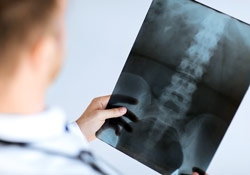
"In December of 2012, I was injured doing a small repair in my home. Testing revealed a herniated disk. I visited Dr. Ben Garrido, and surgery was scheduled and performed. Within hours a significant difference was felt. The staff and professionalism of his office is out of this world fantastic. This will be, from now on, my choice in orthopedic help." -TD
Before a treatment or rehabilitation protocol can be established, Dr. Wood and Dr. Garrido must first determine the reason for and source of your condition. This typically involves a few actions:
- Comprehensive physical examination
- Detailed medical history profile
- Complete history and description of the symptoms related to your condition.
During this initial gathering of information, Dr. Wood and Dr. Garrido should be told whether or not there are other illnesses, injuries or complaints associated with the pain or condition, as well as any previous treatments or medications prescribed. Preliminary diagnostic tests may then follow.
Dr. Garrido and Dr. Wood use various precise tests to accurately diagnose the location and cause of your pain, which may include any of the following:
- Blood tests: blood drawn and then sent to a lab for processing.
- Bone Scan: a small quantity of a radiographic marker is injected intraveniously into the patient after which a scanner is used over the area being examined. The scanner detects the marker, which pools in any region exhibiting high bone turnover; often used for conditions that create high bone turnover, such as tumor, infection or small fractures.
- CAT/CT (computed axial tomography) Scan: a painless imaging technique that uses a computer to produce three-dimensional images of a body, including bone and metal devices.
- DEXA (Dual Energy X-ray Absorptiometry) Scan: a scan takng up to 30 minutes that measures bone mineral density to check for possible bone loss requires the patient to lie fully clothed on a table while the DEXA scanner beams x-rays from two sources towards the bone. A device that detects radiation is slowly passed over the area being examined, which produces images displayed on a monitor. A computer analyzes the images and calculates bone density based on the amount of radiation absorbed by the bone.
- Discogram: used to determine whether a spinal disc is the cause of back or radicular pain, the doctor uses a fluoroscope for guidance while injecting radiopaque dye into the nucleus (center) of the spinal disc. If the dye leaks out of the nucleus into the surrounding tissue, the disc is considered abnormal.
- MRI (magnetic resonance imaging): a useful non-invasive technique for capturing images of the spine that involves rotating a magnet around the body, which in turn excites the hydrogen atoms that are detected by a scanner.
- Myelogram: after injection of a radiographic contrast dye into the sac surrounding the spinal cord and nerves, x-rays are then taken of the spine, which highlight the nerve roots to identify any abnormalities, such as nerve compression or a ruptured disc.
- Nerve Conduction Velocit: Nerve conduction velocity is often used along with an EMG to differentiate a nerve disorder from a muscle disorder. NCV detects a problem with the nerve whereas an EMG detects whether the muscle is functioning properly in response to the nerve's stimulus.
- X-ray: a pain-free non-invasive imaging process. Images are used to diagnose the root cause of spine or back pain and monitor treatment.